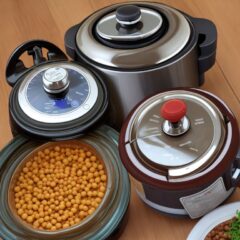
Introduction: The Importance of Sterilization in Mycology
Growing mushrooms at home is an exciting endeavor, but it comes with its own set of challenges—mainly, battling against contaminants. To win this battle, a reliable pressure cooker is your indispensable ally. In this guide on “How to Use a Pressure Cooker for Mushroom Cultivation,” we'll explore how this essential tool helps eliminate harmful bacteria, molds, and other contaminants that could ruin your mycological projects.
The Science Behind Pressure Cookers: How They Enable Effective Sterilization
At its core, the operation of a pressure cooker relies on basic thermodynamics. Normally, water boils at 100°C (212°F) at sea level, which isn't hot enough to kill all potential contaminants. A pressure cooker, however, traps steam inside, thereby increasing the internal pressure and allowing water to boil at a higher temperature. A cooker that can maintain a pressure of 15 PSI can raise the steam temperature to 121°C (250°F), hot enough to kill almost any microorganism.
Pressure-Temperature Conversion Table
| Pressure (PSI) | Temperature (°C) | Temperature (°F) |
|---|---|---|
| 5 PSI | 108°C | 226°F |
| 10 PSI | 115°C | 239°F |
| 12 PSI | 117°C | 242°F |
| 15 PSI | 121°C | 250°F |

This table can serve as a quick reference for understanding how pressure correlates with temperature in a pressure cooker.
Choosing the Right Pressure Cooker: Factors to Consider
If you're in the market for a pressure cooker, aim for one that can maintain a pressure of 15 PSI. While it's possible to sterilize at lower pressures, you'd have to adjust the sterilization time accordingly, which could be less efficient.
Operational Guidelines: Do's and Don'ts While Using a Pressure Cooker
Operating a pressure cooker may seem straightforward, but it demands attention to detail:
- Check the Seal: Ensure the seal is in good condition to prevent leakage.
- Stove Compatibility: Make sure your stove can handle the heat and weight.
- Water Level: Add enough water to last the entire sterilization process but not so much that it seeps into your jars or bags.
- Pressure Build-Up: Allow the cooker to reach the desired pressure before reducing the heat.
A Cautionary Tale: Why Proper Operation is Crucial
Skipping steps or rushing through the process can lead to unfortunate incidents. For instance, forgetting to monitor the water level could result in the cooker running dry, thereby melting your substrate bags. These devices are not just kitchenware; they're specialized equipment that, if misused, could pose safety risks.
Understanding Sterilization Time: How Long is Long Enough?
The time needed for complete sterilization depends on various factors, such as the density and size of the substrate. For instance, liquid agar will heat up faster than a densely packed block of sawdust. Typically, don't start the timer until the pressure cooker has reached the desired pressure, which could take up to 20 minutes.

Here's the graphic illustrating the suggested sterilization times at 15 PSI for different types of substrates:
- Liquid Agar Solution: 45 minutes – Look at our Petri dishes
- Quart-sized Grain Jars: 90 minutes
- Large Grain Bags (5 lbs): 120 minutes – You can order bags here.
- Large Sawdust Blocks (5 lbs): 150 minutes
Investing in Quality: Pressure Cooker Recommendations for Mushroom Cultivation
When diving into the world of mycology, it's crucial to have reliable equipment. One of the most important tools in your arsenal is a dependable pressure cooker. This section focuses on the best types of pressure cookers for mushroom cultivation, ensuring that you have the most effective sterilization methods at your disposal.
Budget Option
- Commercial Explosion Pot from Germany
- Rating: Average 4.3
- Country of Origin: Germany
- Special Note: To reach 15 PSI, you will need to add 20-23 grams to the jigger or purchase a customized jigger.
- Price: Quite affordable (£112)

- Presto 23 Quart Pressure Canner: Offers good value for money but comes with a rubber seal that may need replacing over time.
Premium Choice
- All American 921 21-Quart Pressure Canner: This is a robust, long-lasting option but is more expensive.
Stoveless Option
- All American Electric Sterilizers: These offer a convenient alternative but may require a special power setup.
Conclusion: Winning the Battle Against Contamination

Having the right pressure cooker and knowing how to use it effectively are essential steps in mycological cultivation. It not only increases your chances of success but also ensures that you're doing it in the safest way possible. Choose wisely, operate carefully, and you'll be well on your way to a fruitful mycological journey.

2 thoughts on “Mastering Mycology: A Guide on How to Use a Pressure Cooker for Mushroom Cultivation”
Budget Option
Commercial Explosion Pot from Germany
Rating: Average 4.3
Country of Origin: Germany
Special Note: To reach 15 PSI, you will need to add 20-23 grams to the jigger or purchase a customized jigger.
Price: Quite affordable (£112)
£112 ? Where is it this price please ?
I like your website, your blog page with lots of useful full of fact & tips articles is brilliant, a great resource !
Your down to earth , clear sale pages with ratios & tips is brilliant.
Just wondering if i could buy some colonised spawn bags using a spore print i have ! 😉 (i am local to you i believe. Somersets County town)
Many thanks
Pearl
Hello! Appreciate your message. To begin, I recommend starting with a spore print and then creating a Liquid Culture. Following that, perform a check on an agar plate, ensuring it’s contamination-free before proceeding to use your LC on grains. I am located in Taunton. Feel free to reach out via email if you require any assistance or guidance.